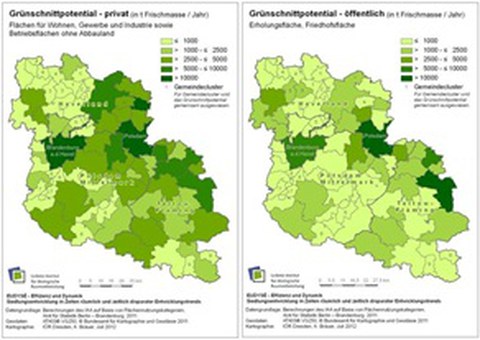research project EUDYSE
Efficiency and Dynamics. Settlement development in times of spatially and temporally disparate trends (EUDYSÉ)
Efficiency and Dynamics. Settlement development in times of spatially and temporally disparate trends
| Partner: | ATB Potsdam-Barnim BIOP Heiligenhafen HCU Hamburg HTW Dresden ILS Dortmund Landkreis Meißen Region Havelland-Fläming |
| Funding: | Bundesministerium für Bildung und Forschung (BMBF) |
| Duration: | January 2011 - February 2014 |
| Contact: | Dipl.-Ing. Axel Zentner |
project description:
The project develops on the basis of two regions and disparate regional development strategies, concepts and methods for a sustainable settlement development. The project focuses on the built environment, land use conflicts and material flows in the areas of energy, water, mineral and organic waste, settlement and traffic. Situational pressures for change, local and regional inefficiencies serve as starting points for finding efficient system solutions.
Including the main problems and taking into account the requirements for resource-efficient and sustainable spatial and settlement development, the topics material flow, energy, water, settlement and traffic are processed along dissonance hypotheses. The regionally specific situations and dynamics of development require regionally adjusted efficiency strategies that are beyond a simple formula. Therefore, two regions are analyzed, which can be separated into three contrasting dynamics of development.
The region Havelland-Fläming stands for growth and shrinkage in a planning area ("grow" "sort"), while the County of Meißen deals primarily with the effects of population decline ("slim").
Objectives:
In the framework of the project the research of the IAA is focused on mineral and organic waste fractions. Organic waste fractions such as kitchen waste and green waste are considered to increase the utilization rate and substitute fossil fuels. Mineral waste is considered to decrease the mining of raw material and save landfill volume as pollutant sink. Parts of the research are the evaluation of the status quo, the making of potential analysis, the detection of dissonances and the development of strategies. Since waste management is not a single discipline synergies with the topics energy, water and settlement are generated.
Investigations:
For two contrasting model regions the theoretic potential of organic waste was determined. The kitchen waste potential was determined by specific rising per inhabitant. The green waste potential was calculated by using GIS-based land use models and specific growth factors for land use categories. After determination of the potential on municipal level gaps between the status quo and spatially distribution could be figured out. However, in the course of acting resource-efficient and low-emission these biomasses can be implemented in energy generation concepts of future settlement developments. For that reason, overlaps between the research fields waste management and energy were figured out to have the same exemplary municipalities twice. Therefore, energy consumption, existing energy supply, potential of native organic waste fractions and potential of renewable resources were used as indicators. Consecutively, local players (waste disposal associations, public landscape maintenance) were contacted to work out strategies and dissonances.
Mineral waste was considered in the County of Meißen. By using GIS-based land use models and an estimation of housing demand prospective anthropogenic stock could be calculated. Consecutively, a management system for C&D waste shall be implemented on a municipal level to increase the utilization rate.
Results:
Currently, approximately 10 % of green waste potential are collected and are subject to material recovery. By cooperation with local players the need to increase the collection and utilization rate could be communicated. Strategies will be worked out to realize their participation. For that reason dissonances still have to be figured out to adapt the processing to the general principles of low-emission and resource-efficiency.
The occurring mineral waste amounts of a chosen municipality could be determined by modeling scenarios. Due to known amounts the need of temporary storage could be calculated. Subsequent these spaces are allocated on maps in order to avoid noise or dust harassment. Prospectively, a management system shall be implemented to promote the recycling of C&D waste to reduce landfilling and increase utilization.
The project is funded by the German Federal Ministry of Education and Research (BMBF).


